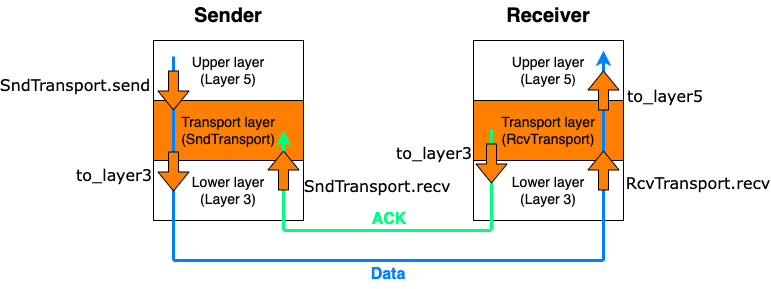Assignment 4: Reliable Transport Protocol
- Part 0: Setup and Overview
- Part 1: Stop and Wait
- Part 2: Sliding Window with a Fixed Window Size
- Submission
- Acknowledgements
Part 0: Setup and Overview
Setup
In this assignment, we recommend you use cs356-base or cs356-p4 profile on CloudLab for implementing and testing your code.
To get the skeleton code, create a private repository by clicking Use this template> Create a repository on the GitHub repository.
Overview
In this assignment, you will implement a transport layer of the network stack running in a simulated environment (i.e., No Kathara).
Your transport layer must ensure reliable transmission of packets even when packet corruptions and losses occur.
In the simulated environment, there is only one sender and receiver pair, and unlike TCP, the connection between them is unidirectional.
The network simulator is included in the provided code (run_sim.py), and you must NOT modify it.
Below are the assumptions in the simulated network environment:
- All packets including ACK packets have a 20-bytes payload. This means the receiver should set a dummy 20-bytes payload in all ACK packets.
- The network simulator guarantees in-order delivery. In other words, the receiver will receive packets in the order that they were sent.
Below is the overview figure for this assignment.

- Transport layers (
SndTransportandRcvTransport): You will implement this part. The transport layer exposes asendAPI to the upper layer and arecvAPI to the lower layer. The transport layer can deliver a message (class Msg) to the upper layer using the providedto_layer5function and a packet (class Pkt) to the lower layer using the providedto_layer3function. - Lower layer (layer 3): This is part of the simulator. Once it receives a packet from the other side, it calls the transport layer’s
recv. If the transport layer callsto_layer3with a packet, it will deliver the packet to the other side. - Upper layer (layer 5): This is also part of the simulator. It periodically sends a message to the other side using the transport layer’s
send. If the transport layer callsto_layer5with a message, the upper layer will receive it.
Part 1: Stop and Wait
In the assignment directory, complete the skeleton code, transport/part1.py.
Please carefully read the comments in the code marked BASIC DATA STRUCTURES and STUDENT-CALLABLE FUNCTIONS.
Tasks
In this part, you will exercise checksum, ACK, and timer-based retransmission, which are the key components of reliable transmission.
Your task is to complete the calc_checksum function and the SndTransport and RcvTransport methods (They are all marked as TODO in the comments).
These will together implement a stop-and-wait protocol (wiki, textbook) in the transport layer.
The sender should wait for an ACK packet after sending a packet, and there can be only one outstanding packet at any time.
Specification
calc_checksum: Write a function that calculates the checksum of a given packet. The checksum must be calculated over the entirePktinstance but the checksum field (i.e.,Pkt.seqnum,Pkt.acknum, andPkt.payload) by using the Internet checksum algorithm (link).SndTransport._init_: Initialize the necessary states for the sender. You MUST use instance variables (e.g.,self.x) instead of global variables to keep the states for both sender and receiver.SndTransport.send: Given a message from the upper layer, create a packet and send it to the lower layer by calling the givento_layer3function. After sending the packet, the program should enable the timer by calling the givenstart_timerfunction. The packet should have a proper sequence number and checksum to ensure reliability against packet loss and corruption. Make sure there’s only one outstanding packet at any time. If this method is called when there’s an unacknowledged packet, simply drop the packet (You may want to abort the process or print an error message).SndTransport.recv: Given a packet from the lower layer, handle the sender’s state, timer, and retransmission based on its validity by checking the acknum and checksum. Since it’s uni-directional, all the received packets are ACK packets.SndTransport.timer_interrupt: This method is called when the sender timer expires. It should retransmit an unacknowledged packet and restart the timer upon timeout.RcvTransport.__init__: Initialize the necessary states for the receiver. You MUST use instance variables (e.g.,self.x) instead of global variables to keep the states for both sender and receiver.RcvTransport.recv: Given a packet from the lower layer, hand over a message to the upper layer and send an ACK packet to the lower layer if the packet is valid. The sequence number and checksum of the packet determine validity. Otherwise, send a NACK packet to the lower layer. Recall that you can express both ACK and NACK with a one-bit sequence number in the stop-and-wait protocol. Since it’s uni-directional, all the received packets are data packets on the receiver side. Please ignoreRcvTransport.timer_interruptif you’re not going to extend this to the bi-directional connection.
Debugging your implementation
We’d recommend setting the tracing level to 4 (by setting -v 4 as a command-line argument) and putting print in your code while you’re debugging.
Test your implementation
Executing the simulator (run_sim.py), you can test your transport code on the simulator. There are multiple command-line arguments to adjust the network simulation environment. Please type python run_sim.py -h for the explanation. You should choose a very large value (e.g., 100000.0) for the average time between messages (-d option) from the sender’s layer 5 so that your sender is never called while it still has an outstanding, unacknowledged message trying to send to the receiver. Here are some sample test cases:
$ python3 run_sim.py -d 100000.0 -z 2 -s [random_seed] -n 10$ python3 run_sim.py -d 100000.0 -z 2 -c 0.1 -l 0.1 -s [random_seed] -n 100$ python3 run_sim.py -d 100000.0 -z 2 -c 0.3 -l 0.3 -s [random_seed] -n 100
Part 2: Sliding Window with a Fixed Window Size
We recommend starting from the part 1 code for this part of the assignment. In the assignment directory, copy your part 1 code by typing $ cp transport/part1.py transport/part2.py and write your part 2 code to transport/part2.py.
Tasks
In this part, you will implement a reliable sliding window protocol (wiki, textbook) that overcomes the utilization problem in the stop-and-wait protocol. It is also a foundation for flow and congestion control. Your task is to modify the methods of SndTransport and RcvTransport in your part 1 code to implement the protocol in the transport layer. The sender can have up to 8 outstanding packets (i.e., the window size is 8).
Specifications
SndTransport._init_: Initialize the necessary states for the sender. It will need more states than Part 1.SndTransport.send: Given a message from the upper layer, create a packet and send it to the lower layer by calling the givento_layer3function. If the packet’s sequence number equals the sliding window’s base sequence number, the program should enable a timer by calling the givenstart_timerfunction. The packet should have a proper sequence number and checksum to ensure reliability against packet loss and corruption. If the number of outstanding unacknowledged packets exceeds or is equal to the window size when the upper layer callsSndTransport.send, simply drop it. (you may want to abort the process or print an error message and return.)SndTransport.recv: Given a packet from the lower layer, handle the sender’s state, including sliding window and buffer, timer, and retransmission based on its validity by checking the acknum and checksum. Since it’s uni-directional, all the received packets are ACK packets.SndTransport.timer_interrupt: This method is called when the sender timer expires. It should perform retransmission of all outstanding unacknowledged packets and restart the timer upon timeout.RcvTransport.__init__: Initialize the necessary states for the receiver. It will need more states than Part 1. You MUST use instance variables instead of global variables to keep the states for sender and receiver.RcvTransport.recv: Given a packet from the lower layer, hand it over to the upper layer and send an ACK packet to the lower layer if the packet is valid. The sequence number and checksum of the packet determine validity. Otherwise, resend the ACK for the most recent valid data packet.
Debugging your implementation
We’d recommend setting the tracing level to 4 (by setting -v 4 as a command-line argument) and putting print in your code while you’re debugging.
Test your implementation
To test your part2 implementation, you MUST change from transport.part1 import SndTransport, RcvTransport, Msg, Pkt to from transport.part2 import SndTransport, RcvTransport, Msg, Pkt in the provided run_sim.py. Now, you don’t have to choose a very large value (e.g., 100000.0) for the average time between messages from the sender’s layer 5, since there could be multiple in-flight packets with the sliding window protocol. Here are some sample test cases:
$ python3 run_sim.py -d 50.0 -z 32 -s [random_seed] -n 10$ python3 run_sim.py -d 50.0 -z 32 -c 0.1 -l 0.1 -s [random_seed] -n 100$ python3 run_sim.py -d 50.0 -z 32 -c 0.3 -l 0.3 -s [random_seed] -n 100
Submission
Please submit your code (modified assignment4 repository) including part1.py and part2.py to the Canvas Assignments page in either tar.gz or zip format.
The naming format for the file is assign4_groupX.[tar.gz/zip].
Acknowledgements
This assignment is from the authors’ website for Computer Networking: a Top Down Approach (by Jim Kurose and Keith Ross).
